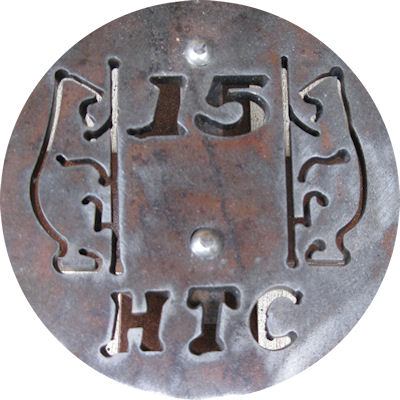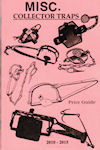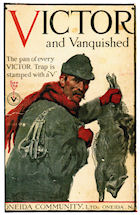|
The Victor brand of traps were made in two models from 1886 to 1889. The first model featured a cast pan and shank dogless and a short latch trigger type in cast pan and shank and a riveted pan in smaller sizes. The second model had small riveted pans on a flat and sideways type post. The pans were stamped Kenwood, Oneida and Oneida Community, N.Y.
The hump cross model was used after 1907 and the "V" was cut into the pans after 1910. The #91 and #91 1/2 Victor was used to replace that size in the Newhouse line. Later, the 20 series was made to replace the 91 type. All of these changes were to cut production costs, NOT to make a better trap. The Victor Giant was made with several changes in jaw style and pan lettering.
In the year 1938, Victor made a few traps powered by the use of a rubber block. In the same year, the new, and better coil spring trap was made from Gibbs's patents. The first model had "Inside the Lever" type coils with "FOX TRAP" on the pan. A double jaw model was made and had round jaws.
In 1940, the regular square jaw model was made with "FOX TRAP" on the pan for a few years. At this time, the Victor #40 double grip models were introduced. It was also made from Gibbs's patent of the #III, made in 1913.
The first "STOPLOSS" model arrived in the early 1930's. In 1939, the short type spring was introduced, as was the first model with a delayed action plate with the stamping, "USE THIS PLATE TO DELAY ACTION OF GUARD".
The "Two Trigger" model was also made from the Gibb's patent with and without teeth. The #II Special with no cross piece, set with a large, wide trigger over the front of the jaws.
Tests were under way in the 1960's for a rubber jaw type trap. Models were made with surgical tubes on the jaws, solid rubber over the jaws, etc. The final trap used the same type as the old Briddell Custion Grip made in 1938.
|


















